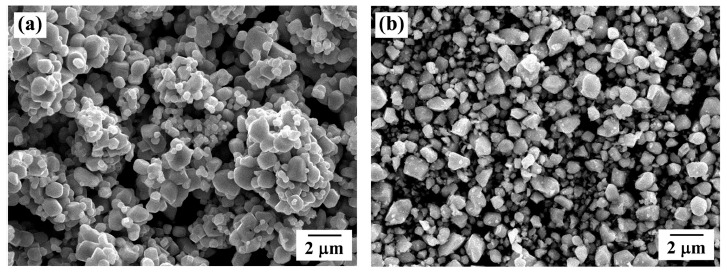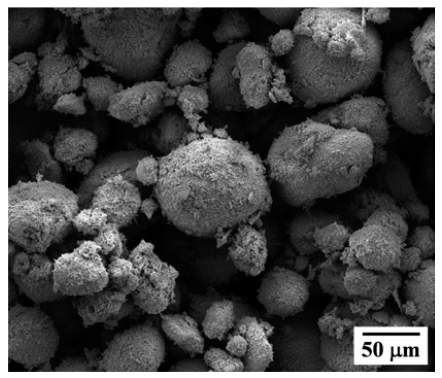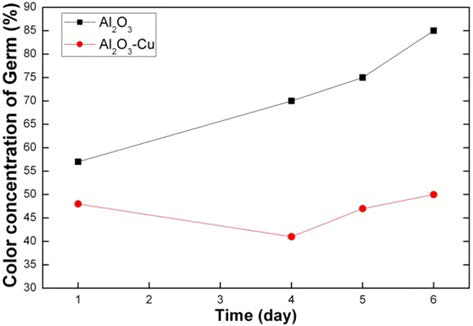Search
- Page Path
- HOME > Search
- [Korean]
- Fabrication of Porous Ni by Freeze Drying and Hydrogen Reduction of NiO/Camphene Slurry
- Jae-Hun Jeong, Sung-Tag Oh, Chang-Yong Hyun
- J Korean Powder Metall Inst. 2019;26(1):6-10. Published online February 1, 2019
- DOI: https://doi.org/10.4150/KPMI.2019.26.1.6

- 746 View
- 2 Download
- 1 Citations
-
 Abstract
Abstract
 PDF
PDF In this study, freeze drying of a porous Ni with unidirectionally aligned pore channels is accomplished by using a NiO powder and camphene. Camphene slurries with NiO content of 5 and 10 vol% are prepared by mixing them with a small amount of dispersant at 50°C. Freezing of a slurry is performed at -25°C while the growth direction of the camphene is unidirectionally controlled. Pores are generated subsequently by sublimation of the camphene during drying in air for 48 h. The green bodies are hydrogen-reduced at 400°C and then sintered at 800°C and 900°C for 1 h. X-ray diffraction analysis reveals that the NiO powder is completely converted to the Ni phase without any reaction phases. The sintered samples show large pores that align parallel pores in the camphene growth direction as well as small pores in the internal walls of large pores. The size of large and small pores decreases with increasing powder content from 5 to 10 vol%. The influence of powder content on the pore structure is explained by the degree of powder rearrangement in slurry and the accumulation behavior of powders in the interdendritic spaces of solidified camphene.
-
Citations
Citations to this article as recorded by- Synthesis of Porous Cu-Co using Freeze Drying Process of Camphene Slurry with Oxide Composite Powders
Gyuhwi Lee, Ju-Yeon Han, Sung-Tag Oh
Journal of Korean Powder Metallurgy Institute.2020; 27(3): 193. CrossRef
- Synthesis of Porous Cu-Co using Freeze Drying Process of Camphene Slurry with Oxide Composite Powders
- [Korean]
- Effect of Freezing and Sintering Condition of CuO-SnO2/Camphene Slurries on the Pore Structure of Porous Cu-Sn
- Joo-Hyung Kim, Sung-Tag Oh, Chang-Yong Hyun
- J Korean Powder Metall Inst. 2016;23(1):49-53. Published online February 1, 2016
- DOI: https://doi.org/10.4150/KPMI.2016.23.1.49

- 556 View
- 1 Download
- 3 Citations
-
 Abstract
Abstract
 PDF
PDF The present study demonstrates the effect of freezing conditions on the pore structure of porous Cu-10 wt.% Sn prepared by freeze drying of CuO-SnO2/camphene slurry. Mixtures of CuO and SnO2 powders are prepared by ball milling for 10 h. Camphene slurries with 10 vol.% of CuO-SnO2 are unidirectionally frozen in a mold maintained at a temperature of -30°C for 1 and 24 h, respectively. Pores are generated by the sublimation of camphene at room temperature. After hydrogen reduction and sintering at 650°C for 2 h, the green body of the CuO-SnO2 is completely converted into porous Cu-Sn alloy. Microstructural observation reveals that the sintered samples have large pores which are aligned parallel to the camphene growth direction. The size of the large pores increases from 150 to 300 μm with an increase in the holding time. Also, the internal walls of the large pores contain relatively small pores whose size increases with the holding time. The change in pore structure is explained by the growth behavior of the camphene crystals and rearrangement of the solid particles during the freezing process.
-
Citations
Citations to this article as recorded by- Fabrication of Porous Ni by Freeze Drying and Hydrogen Reduction of NiO/Camphene Slurry
Jae-Hun Jeong, Sung-Tag Oh, Chang-Yong Hyun
Journal of Korean Powder Metallurgy Institute.2019; 26(1): 6. CrossRef - Fabrication of Al2O3 Dispersed Porous Cu by Freeze Drying of CuO-Al2O3/Camphene Slurry
Hyunji Kang, Doh-Hyung Riu, Sung-Tag Oh
journal of Korean Powder Metallurgy Institute.2018; 25(1): 25. CrossRef - Porous W-Ni Alloys Synthesized from Camphene/WO3-NiO Slurry by Freeze Drying and Heat Treatment in Hydrogen Atmosphere
Sung Hyun Park, Seong-Min Park, So-Jeong Park, Bo-Yeong Park, Sung-Tag Oh
Korean Journal of Materials Research.2018; 28(2): 108. CrossRef
- Fabrication of Porous Ni by Freeze Drying and Hydrogen Reduction of NiO/Camphene Slurry
- [Korean]
- Synthesis and Antifungal Property of Porous Al2O3 with Dispersions of Cu Nanoparticles
- Ho-Suk Yoo, Min-Sung Kim, Sung-Tag Oh, Chang-Yong Hyun
- J Korean Powder Metall Inst. 2014;21(1):16-20. Published online February 1, 2014
- DOI: https://doi.org/10.4150/KPMI.2014.21.1.16

- 807 View
- 1 Download
- 2 Citations
-
 Abstract
Abstract
 PDF
PDF In order to fabricate the porous Al2O3 with dispersion of nano-sized Cu particles, freeze-drying of camphene/ Al2O3 slurry and solution chemistry process using Cu-nitrate are introduced. Camphene slurries with 10 vol% Al2O3 was frozen at -25°C. Pores were generated by sublimation of the camphene during drying in air. The sintered samples at 1400 and 1500°C showed the same size of large pores which were aligned parallel to the sublimable vehicles growth direction. However, the size of fine pores in the internal walls of large pores decreased with increase in sintering temperature. It was shown that Cu particles with the size of 100 nm were homogeneously dispersed on the surfaces of the large pores. Antibacterial test using fungus revealed that the porous Al2O3/1 vol% Cu composite showed antifungal property due to the dispersion of Cu particles. The results are suggested that the porous composites with required pore characteristics and functional property can be fabricated by freeze-drying process and addition of functional nano particles by chemical method.
-
Citations
Citations to this article as recorded by- Collection of Industrial Oil Using Nanoparticles and Porous Powders of Silica
Y.-S. Cho, J.-W. Moon
Archives of Metallurgy and Materials.2017; 62(2): 1371. CrossRef - Fabrication and Mechanical Properties of STS316L Porous Metal for Vacuum Injection Mold
Se Hoon Kim, Sang Min Kim, Sang Ho Noh, Jin Pyeong Kim, Jae Hyuck Shin, Si-Young Sung, Jin Kwang Jin, Taean Kim
Journal of Korean Powder Metallurgy Institute.2015; 22(3): 197. CrossRef
- Collection of Industrial Oil Using Nanoparticles and Porous Powders of Silica
- [Korean]
- Direct Bonding of Cu/AlN using Cu-Cu2O Eutectic Liquid
- Junsung Hong, Jung-Hoon Lee, You-Na Oh, Kwang-Jun Cho, Doh-Hyung Riu, Sung-Tag Oh, Chang-Yong Hyun
- J Korean Powder Metall Inst. 2013;20(2):114-119.
- DOI: https://doi.org/10.4150/KPMI.2013.20.2.114

- 675 View
- 0 Download
- 1 Citations
-
 Abstract
Abstract
 PDF
PDF - In the DBC (direct bonding of copper) process the oxygen partial pressure surrounding the AlN/Cu bonding pairs has been controlled by Ar gas mixed with oxygen. However, the direct bonding of Cu with sound interface and good adhesion strength is complicated process due to the difficulty in the exact control of oxygen partial pressure by using Ar gas. In this study, we have utilized the in-situ equilibrium established during the reaction of 2CuOrightarrowCu_2O + 1/2 O_2 by placing powder bed of CuO or Cu_2O around the Cu/AlN bonding pair at 1065sim1085°C. The adhesion strength was relatively better in case of using CuO powder than when Cu_2O powder was used. Microstructural analysis by optical microscopy and XRD revealed that the interface of bonding pair was composed of Cu_2O, Cu and small amount of CuO phase. Thus, it is explained that the good adhesion between Cu and AlN is attributed to the wetting of eutectic liquid formed by reaction of Cu and Cu_2O.
-
Citations
Citations to this article as recorded by- Low-Temperature Sintering Behavior of Aluminum Nitride Ceramics with Added Copper Oxide or Copper
Jin-Geun Hwang, Kyung-Sik Oh, Tai-Joo Chung, Tae-Heui Kim, Yeong-Kyeun Paek
Journal of the Korean Ceramic Society.2019; 56(1): 104. CrossRef
- Low-Temperature Sintering Behavior of Aluminum Nitride Ceramics with Added Copper Oxide or Copper
- [Korean]
- Evaluation of Creep Reliability of Powder Metallurgy and Cast-type Ni-based Superalloy by Using Ultrasonic Wave
- Chan-Yang Choi, Jin-Hun Song, Se-Ung Oh, Chung-Seok Kim, Sook-In Kwun, Sung-Tag Oh, Chang-Yong Hyun, Jai-Won Byeon
- J Korean Powder Metall Inst. 2012;19(3):215-219.
- DOI: https://doi.org/10.4150/KPMI.2012.19.3.215

- 331 View
- 0 Download
-
 Abstract
Abstract
 PDF
PDF - An attempt was made to evaluate creep reliability of two commercial Ni-based superalloys by using ultrasonic wave. The materials include fine-grained PM alloy fabricated by mechanical alloying and subsequent hot isostatic pressing, and IN738LC cast alloy with a grain size of a few cm. Microstructural parameters (fraction of creep cavity and size of gammaprime precipitates) and ultrasonic parameters (velocity, attenuation) were measured to try to find relationships between them. Ultrasonic velocity decreased with creep cavity formation in PM alloy. On the other hand, no distinct changing trend of ultrasonic velocity was observed for IN738LC alloy. Ultrasonic attenuation was found to have a linear correlation with the size of gammaprime precipitates and was suggested as a potential parameter for monitoring creep reliability of IN738LC alloy.
- [Korean]
- Improvement of Pot Life in the Epoxy Resin-based Adhesive Formulation by Size Control and Coating of Curing Accelerator Powders
- Jun-Sik Lee, Chang-Yong Hyun, Jong-Hyun Lee
- J Korean Powder Metall Inst. 2008;15(2):119-124.
- DOI: https://doi.org/10.4150/KPMI.2008.15.2.119

- 600 View
- 8 Download
- 1 Citations
-
 Abstract
Abstract
 PDF
PDF - To increase pot life in the formulation mixed with bisphenol F epoxy resin, anhydride-based curing agent, and imidazole-based curing accelerator powders as a paste material for high-speed RFID chip bonding, size variation of the imidazole-based powders and a coating method of the powders were adopted in this study. In experiment with regard to the size variation, the pot life was not outstandingly increased. Through the idea using the coating method, however, the pot life was increased up to 4.25 times in comparison with the addition of initial imidazole-based powders. Consequently, successive bonding of RFID chip could be performed with very short time of 5sec using the suggested formulation having improved pot life.
-
Citations
Citations to this article as recorded by- Applications of Epoxy Resins as a Coating Technology in Fluid Systems
Taiba Kouser, Farahah Nur, Abdulrahman Aliyu, Faizah Altaf, Hina Zulfiqar, Luai M. Alhems
ChemBioEng Reviews.2025;[Epub] CrossRef
- Applications of Epoxy Resins as a Coating Technology in Fluid Systems
- [Korean]
- Magnetic Pulsed Compaction and Sintering Characteristics of Al Composite Powders Reinforced with Waste Stainless Steel Short Fibers
- Chang-Yong Hyun, Chul-Hyun Won, Jae-Soon Park
- J Korean Powder Metall Inst. 2007;14(6):380-385.
- DOI: https://doi.org/10.4150/KPMI.2007.14.6.380

- 416 View
- 1 Download
-
 Abstract
Abstract
 PDF
PDF - Characteristics of Al-based composites with waste stainless steel short fiber, fabricated by magnetic pulsed compaction and sintering were investigated. The compacts prepared by magnetic pulsed compaction showed high relative density and homogeneous microstructure compared with that by conventional press compaction. The relative density of sintered composites at 430°C for 1 h exhibited the same value with compacts and decreased with increase in STS short fiber content. The reaction between Al and STS phase was confirmed by the microstructural analysis using EDS. The sintered composites, prepared by magnetic pulsed compaction, showed increased hardness value with increasing STS fiber content. Maximum yield strength of 100 MPa and tensile strength of 232 MPa were registered in the AI-based composite with 30 vol% STS short fiber.
TOP
 KPMI
KPMI


 First
First Prev
Prev


